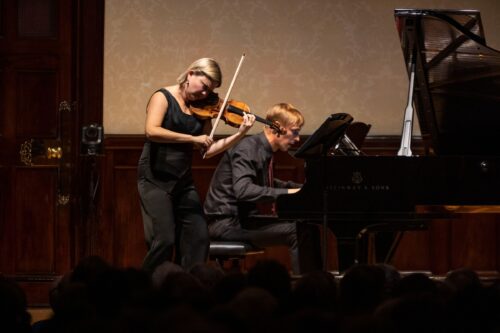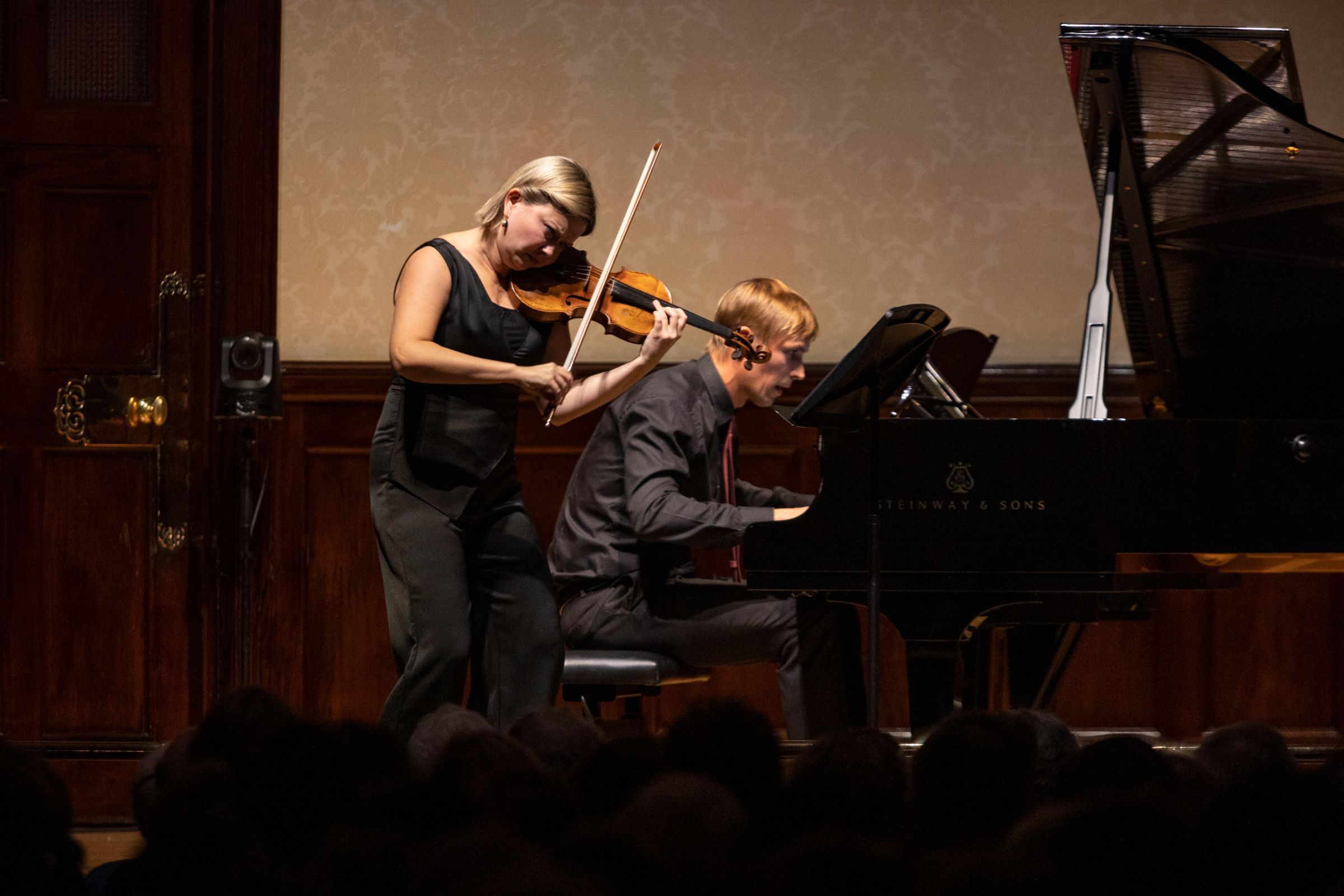 United Kingdom Szymanowski, Poulenc, Ysaÿe, Ravel: Alina Ibragimova (violin), Cédric Tiberghien (piano). Wigmore Hall, London, 5.10.2021. (CS)
United Kingdom Szymanowski, Poulenc, Ysaÿe, Ravel: Alina Ibragimova (violin), Cédric Tiberghien (piano). Wigmore Hall, London, 5.10.2021. (CS)

Szymanowski – Myths Op.30
Poulenc – Violin Sonata
Ysaÿe – Poème élégiaque Op.12
Ravel – Violin Sonata No.2 in G
Violinist Alina Ibragimova and pianist Cédric Tiberghien are surely ideal musical partners. They both play with immensely strong definition and character, absolute technical command and unwavering musical direction. Their performances are not so much a marriage of equal voices but an integration of complementary spirits. And, there’s a seriousness of purpose that demands as much of the listener as they require of themselves. This French-dominated recital at Wigmore Hall both challenged and captivated from the first note to the last, the music insisting, through the intensity of the performers’ communicativeness and the astonishing detail of their interpretations, on a deep and sustained attentiveness from its audience.
The programme was perfectly attuned to the musicians’ temperaments and manner. The works performed blend refinement and rigour with fire and freedom, the moods modulating mercurially between impassioned sensuousness, elegant exoticism and classical poise. Ibragimova’s technical command is so effortless that it seems unnecessary even to comment on the flawless intonation and fearless vanquishing of even the most vertiginous violinistic mountains. It is her ability to vary her timbre, and to move between extremes – cool and chaste one moment, throbbing with an almost violent energy the next – that is so exceptional and compelling. And, Tiberghien does not only respond instinctively to the violin’s confident purposefulness, but plays with a distinct poetic voice that is an essential component in the shaping of the musical journey.
The opening of ‘La Fontaine d’Aréthuse’, the first of Szymanowski’s three Myths, epitomised the magic of the tapestries of musical imagery that the duo spun throughout the recital. Murmuring, delicate, the piano’s trembling motions evoked the movements of the natural world, into which Ibragimova penetrated with cool purity, her soaring song clean and sure. There was a real sense of mystery, the music seeming to quiver on the edge of rapture as the piano’s arabesques swirled lightly, with rhythmic liberty. Ibragimova found more colours, shades and textures than one might think possible, brilliantly exploiting the extensive harmonics, glissandi and bow techniques that Szymanowski demands, until in the latter part of the movement the impressionistic landscape a rich warmth sweetened the melodies which convey Arethusa’s flight. A lovely calm infused the start of ‘Narcissus’, the violin singing elegantly above the piano’s gently swaying syncopations, and throughout the movement noble composure and impassioned energy were skilfully and insightfully integrated. In ‘Dryads and Pan’ one could almost feel the cobwebby shimmer of the nocturnal forest, and the tactile complexity of the natural world was matched by emotional diversity, the music by turns jumpy, playful and amorous. At the close, Pan’s tranquil pipe faded invitingly into the night air.
Poulenc professed not to be enamoured of the violin – ‘To tell the truth, I don’t like the violin in the singular. In the plural, it’s quite different.’ – and it took him several attempts to complete a violin sonata that satisfied him. His first effort, in 1919, was withdrawn almost immediately; the second, in 1924, suffered similarly, the composer remarking, ‘It met the same fate as my quartet. I wrang its neck rather than let the public see it.’ In 1943, Poulenc eventually completed a sonata that satisfied him, although even this was subject to revision six years later.
Written during the German occupation of France, the Sonata is dedicated to Spanish poet Federico Garcia Lorca, who had fought and was killed in the Spanish Civil War in 1936, and perhaps one is tempted to hear a lingering tragic note – and also anger in the dry snap and crunch of the opening bars of the Allegro con fuoco which Ibragimova launched with vehemence and bite. The interweaving of different styles and influences – from the salon to Stravinsky – can make the music seem jittery, even jumbled, at times, but the duo relished the fragmentations and freedom, the melodies surfacing for air above the dense counterpoint and movement. We entered a twilight zone in the Intermezzo, the piano’s melancholy murmur the merest whisper at the start, before gentle splashes of colour warmed the shadows. Perhaps a slightly headier languor might have pulsed through the violin’s melody when it pushed to the foreground, emerging then receding again, but the tenderness of Ibragimova and Tiberghien’s elegiac restraint was affecting – perhaps fulfilling Poulenc’s wish to match what he called the ‘instrumental tact’ of Debussy’s Violin Sonata. The final Presto tragico drove forward brusquely, unrelentingly, eventually burning out its own agitation.
Ysaÿe’s Poème élégiaque was beautifully dark and burnished, especially in the central sombre, mournful section, and the relaxation and breadth of the phrases was welcome. But there was storming momentum too, in the perfectly tuned octaves that pushed towards melodic release, and – following poetic improvisatory searching – quiet, dignified resignation at the close. Given Ibragimova’s infinite colour palette, Tiberghien’s light-fingered iridescence, and the duo’s ability to switch between diverse moods with seeming spontaneity and masterly persuasiveness, Ravel is a natural recital choice and this concert closed with the composer’s Second Sonata. The Allegretto was loose and limpid at the opening, the calm melody tousled by the violin’s fluttering G-string gestures, answered with elegance by Tiberghien. This was an intimate performance, every detail carefully etched and caressed, and there was a certain note of fragility at times. The first time I heard this Sonata performed live was when a young Nigel Kennedy entertained a regional music club with a programme which also included Brahms, Bartók and Jimi Hendrix. It was one of those seminal ‘teenage moments’ for me, and I recall being astonished by the bluesy second movement in particular. Here, I felt that there could have been a few more rhythmic risks taken, but there was a terrific contrast between the restraint and release that the duo crafted. Of the Perpetuum mobile, all I can say is, wow.
The second of Szymanowski’s three Paganini Caprices was a dulcet encore, the rhapsodic silkiness of which sent us, comforted and inspired, into the night.
Claire Seymour
